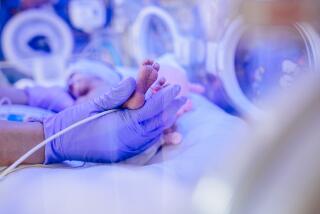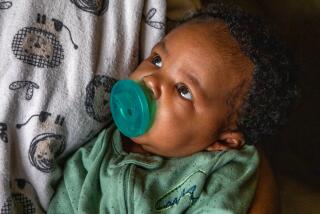Panel Questions Effectiveness of Home Crib-Death Monitors
- Share via
WASHINGTON — A National Institutes of Health panel, questioning the effectiveness of cardiorespiratory home monitoring on infants, Wednesday recommended the procedure only for babies who are at exceptionally high risk of crib death.
The panel said the monitoring could save lives in high-risk cases but that the expensive and time-consuming device has not proved to be sufficiently effective to warrant use in many cases. The panel, finding that some infants died while being monitored at home even when the procedure was performed correctly, called for further evaluation of the devices.
It urged that monitoring be routinely recommended only for infants who have had what it called a severe apparent life-threatening event--which is an episode of apnea, or cessation of breathing that requires vigorous stimulation or resuscitation--or infants with two or more siblings who fell victim to crib death, formally known as sudden infant death syndrome, in which there is no determinable cause of death.
Others at High Risk
Several other groups--infants with a sibling who was a victim of sudden infant death syndrome, infants with less severe apnea episodes and infants whose mothers abuse cocaine or opiates--are also at high risk, the panel said. But, because evidence on the benefits and risks of monitoring in those groups is inconclusive, the panel recommended that such cases be evaluated individually.
The most commonly used monitor operates by interpreting information received from two or three rubber pads attached to the chest of the infant, sounding an alarm when breathing or heartbeat is interrupted.
The monitors are generally effective in identifying and signaling distress, the panel report said, but sometimes produce erroneous results, such as setting off an alarm when the infant is breathing. But, even when the monitors were operating correctly, infants have died because of inappropriate response by the person reacting to the alarm, which emphasizes the importance of carefully educating those who monitor the devices.
Frequency of Deaths
Monitoring of healthy infants and those with apnea associated with premature birth is unwarranted, the panel said.
“If the criteria we’re recommending are put in place, we would significantly decrease the number of home monitors in use in this country,” said Dr. George A. Little of Dartmouth Medical School, who headed the panel. The Food and Drug Administration estimates that between 40,000 and 45,000 monitors are in use. Sudden infant death syndrome occurs about twice in every 1,000 live births in the United States.
“The information we had seemed to indicate that a large number of babies enter into monitoring when it is not necessary . . . or are monitored longer than is necessary,” Little said.
In addition, the panel criticized some parents, noting that some either refused to use a monitor at home or were lax in following recommendations.






